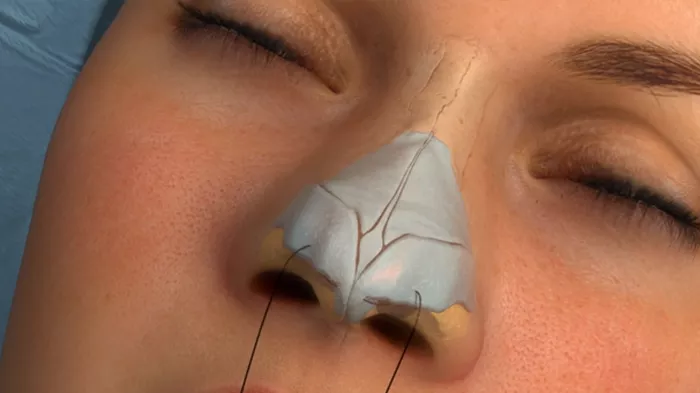Deviated septum surgery, known as septoplasty, is a surgical procedure aimed at correcting a deviated septum to improve nasal function and alleviate associated symptoms. One common concern among individuals contemplating septoplasty is the level of pain associated with the surgery. This comprehensive article aims to provide insights into the pain levels of deviated septum surgery, addressing concerns and guiding individuals through the preoperative, perioperative, and postoperative phases.
Understanding Deviated Septum and the Need for Surgery
Defining a Deviated Septum
A deviated septum occurs when the thin wall of cartilage and bone that divides the nasal passages is off-center or crooked. This condition can lead to various nasal issues, including difficulty breathing, nasal congestion, snoring, and recurrent sinus infections. Septoplasty becomes a recommended solution when conservative measures fail to address these symptoms.
Purpose of Septoplasty
Septoplasty aims to straighten the deviated septum, improving airflow through the nasal passages. By correcting the structural abnormality, septoplasty not only addresses functional issues but can also enhance overall nasal health and well-being.
Deviated Septum Surgery
Surgical Techniques
During septoplasty, the surgeon makes an incision inside the nose to access the deviated septum. The extent of correction may involve removing or reshaping the deviated portions of the septum. The goal is to restore the septum to its proper position, allowing for optimal nasal function.
Anesthesia during Septoplasty
Septoplasty is typically performed under either local or general anesthesia, depending on the complexity of the procedure and the patient’s preference. Local anesthesia numbs the surgical area, and general anesthesia induces a temporary state of unconsciousness.
Preoperative Considerations
Surgical Consultation
During the preoperative phase, patients undergo a thorough consultation with the surgeon. This is an opportunity to discuss the details of the surgery, including potential discomfort, and address any concerns the patient may have. Surgeons provide realistic expectations and information about postoperative care.
Pain Management Planning
As part of the preoperative planning, pain management strategies are discussed. Surgeons may prescribe pain medications to manage discomfort during the immediate postoperative period. Understanding the available options and their potential side effects is crucial for informed decision-making.
Perioperative Phase
Anesthesia Administration
Once in the operating room, the chosen anesthesia is administered by a qualified anesthesiologist. Local anesthesia is commonly used for septoplasty, allowing the patient to remain awake but comfortable during the procedure. General anesthesia may be preferred for more extensive cases.
Surgeon’s Expertise
The skill and expertise of the surgeon play a significant role in minimizing discomfort during and after septoplasty. A skilled surgeon can perform the procedure efficiently, reducing the duration of surgery and associated anesthesia exposure.
Immediate Postoperative Period
Discomfort versus Pain
After septoplasty, it is common for patients to experience some discomfort during the immediate postoperative period. Discomfort may include sensations of pressure, congestion, or a feeling of fullness in the nose. It is crucial to distinguish between discomfort, which is expected, and intense pain, which should be promptly addressed.
Pain Management
Surgeons typically prescribe pain medications to manage discomfort during the initial recovery period. Over-the-counter pain relievers, such as acetaminophen, are commonly recommended. Additionally, applying cooling packs to the surgical site can help reduce swelling and provide relief.
Factors Influencing Postoperative Discomfort
Individual Pain Thresholds
Individual variations in pain thresholds can significantly influence the level of discomfort experienced after septoplasty. Surgeons consider these variations when prescribing pain medications and adjusting the postoperative care plan.
Surgical Complexity
The complexity of the septoplasty procedure can impact postoperative discomfort. Extensive septal deviations or additional procedures, such as turbinate reduction, may contribute to a higher level of discomfort during the initial recovery period. Surgeons provide detailed information about the anticipated level of postoperative discomfort based on the specifics of each case.
Managing Discomfort
Rest and Elevation
Rest is a key component of the recovery process after septoplasty. Patients are advised to take it easy for the first few days, avoiding strenuous activities. Keeping the head elevated, even during sleep, can help minimize swelling and contribute to overall comfort.
Hydration and Nutrition
Staying hydrated and maintaining proper nutrition are essential aspects of the recovery process. Hydration supports the healing of tissues, and a well-balanced diet provides the necessary nutrients for optimal recovery. Patients are encouraged to follow postoperative care guidelines for dietary considerations.
Long-Term Comfort
Gradual Improvement
As the initial recovery period progresses, patients typically experience a gradual improvement in comfort. Discomfort and swelling diminish, and breathing through the nose becomes easier. Following postoperative care instructions, including regular saline nasal rinses, helps promote long-term comfort and optimal healing.
Follow-Up Appointments
Surgeons schedule follow-up appointments to monitor the progress of healing. During these appointments, the surgeon assesses the surgical site, addresses any concerns the patient may have, and provides guidance on the ongoing recovery process. These appointments contribute to the overall comfort and success of septoplasty.
Rare Complications and Persistent Discomfort
Uncommon Side Effects
While septoplasty is generally well-tolerated, uncommon side effects or complications can contribute to persistent discomfort. These may include infection, bleeding, or an adverse reaction to anesthesia. Surgeons educate patients about potential complications and provide guidance on when to seek prompt medical attention.
Addressing Persistent Discomfort
If a patient experiences persistent or increasing discomfort beyond the expected recovery period, it is crucial to communicate with the surgeon promptly. Identifying and addressing the cause of ongoing discomfort ensures timely intervention and optimal outcomes.
Conclusion
In conclusion, while septoplasty involves some level of discomfort during the immediate postoperative period, it is generally well-tolerated, and pain is effectively managed through medications and proper care. Understanding the nuances of discomfort, individual variations in pain perception, and the importance of postoperative care guidelines allows patients to make informed decisions and confidently embrace the functional benefits of deviated septum surgery.


